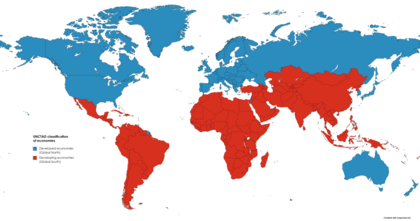
Global North and Global South are terms that denote a method of grouping countries based on their defining characteristics with regard to socioeconomics and politics. According to UN Trade and Development (UNCTAD), the Global South broadly comprises Africa, Latin America and the Caribbean, Asia (excluding Israel, Japan, and South Korea), and Oceania (excluding Australia and New Zealand).[1][3][a] Most of the Global South's countries are commonly identified as lacking in their standard of living, which includes having lower incomes, high levels of poverty, high population growth rates, inadequate housing, limited educational opportunities, and deficient health systems, among other issues.[b] Additionally, these countries' cities are characterized by their poor infrastructure.[c] Opposite to the Global South is the Global North, which the UNCTAD describes as broadly comprising Northern America and Europe, Israel, Japan, South Korea, Australia, and New Zealand.[1][3][a] As such, the two terms do not refer to the Northern Hemisphere or the Southern Hemisphere, as many of the Global South's countries are geographically located in the former and, similarly, a number of the Global North's countries are geographically located in the latter.[4]
More specifically, the Global North consists of the world's developed countries, whereas the Global South consists of the world's developing countries and least developed countries.[3][5] The Global South classification, as used by governmental and developmental organizations, was first introduced as a more open and value-free alternative to “Third World”,[6] and likewise potentially “valuing” terms such as developed and developing. Countries of the Global South have also been described as being newly industrialized or in the process of industrializing, many of them are current or former subjects of colonialism.[7]
The Global North and the Global South are often defined in terms of their differing levels of wealth, economic development, income inequality, and strength of democracy, as well as by their political freedom and economic freedom, as defined by a variety of freedom indices. Countries of the Global North tend to be wealthier, and capable of exporting technologically advanced manufactured products, among other characteristics. In contrast, countries of the Global South tend to be poorer, and heavily dependent on their largely agrarian-based economic primary sectors.[d] Some scholars have suggested that the inequality gap between the Global North and the Global South has been narrowing due to the effects of globalization.[8] Other scholars have disputed this position, suggesting that the Global South has instead become poorer vis-à-vis the Global North in this same timeframe.[9][10][11]
Since World War II, the phenomenon of “South–South cooperation” (SSC) to “challenge the political and economic dominance of the North” has become more prominent among the Global South's countries.[12][13][14] It has become popular in light of the geographical migration of manufacturing and production activity from the Global North to the Global South,[14] and has since influenced the diplomatic policies of the Global South’s more powerful countries, such as China.[14] Thus, these contemporary economic trends have “enhanced the historical potential of economic growth and industrialization in the Global South” amidst renewed targeted efforts by the SSC to “loosen the strictures imposed during the colonial era, and transcend the boundaries of postwar political and economic geography” as an aspect of decolonization.[15]
- ^ a b c Cite error: The named reference
UNCTADwas invoked but never defined (see the help page). - ^ "Classifications - UNCTAD Handbook of Statistics 2023". unctad.org.
- ^ a b c d "Handbook of Statistics 2022" (PDF). unctad.org. p. 21. Archived (PDF) from the original on 12 December 2022.
Note: North refers to developed economies, South to developing economies; trade is measured from the export side; deliveries to ship stores and bunkers as well as minor and special-category exports with unspecified destination are not included.
- ^ "Introduction: Concepts of the Global South". gssc.uni-koeln.de. Archived from the original on 4 September 2016. Retrieved 18 October 2016., "Concepts of the Global South" (PDF). gssc.uni-koeln.de. Retrieved 10 March 2024.
- ^ Nora, Mareï; Michel, Savy (January 2021). "Global South countries: The dark side of city logistics. Dualisation vs Bipolarisation". Transport Policy. 100: 150–160. doi:10.1016/j.tranpol.2020.11.001. S2CID 228984747.
This article aims to appraise the unevenness of logistics development throughout the world, by comparing city logistics (notion that we define) between developing countries (or Global South countries) (where 'modern' and 'traditional' models often coexist) and developed countries (or Global North countries)
- ^ Mitlin, Diana; Satterthwaite, David (2013). Urban Poverty in the Global South: Scale and Nature. Routledge. p. 13. ISBN 9780415624664 – via Google Books.
- ^ Mimiko, Nahzeem Oluwafemi (2012). Globalization: The Politics of Global Economic Relations and International Business. Carolina Academic Press. p. 47. ISBN 978-1-61163-129-6.
- ^ Therien, Jean-Philippe (August 1999). "Beyond the North-South divide: The two tales of world poverty". Third World Quarterly. 20 (4): 723–742. doi:10.1080/01436599913523.
- ^ Cite error: The named reference
Hickel2016was invoked but never defined (see the help page). - ^ Cite error: The named reference
Hickel2020was invoked but never defined (see the help page). - ^ Cite error: The named reference
Hickel 2021was invoked but never defined (see the help page). - ^ Cite error: The named reference
:0awas invoked but never defined (see the help page). - ^ Cite error: The named reference
:0bwas invoked but never defined (see the help page). - ^ a b c Acharya, Amitav (3 July 2016). "Studying the Bandung conference from a Global IR perspective". Australian Journal of International Affairs. 70 (4): 342–357. doi:10.1080/10357718.2016.1168359. S2CID 156589520.
- ^ Cite error: The named reference
:4was invoked but never defined (see the help page).
Cite error: There are <ref group=lower-alpha> tags or {{efn}} templates on this page, but the references will not show without a {{reflist|group=lower-alpha}} template or {{notelist}} template (see the help page).